The global magnetic coupler market is projected to expand from USD 598.9 million in 2025 to USD 1,189.2 million by 2035, advancing at a CAGR of 7.1% and effectively doubling in value over the forecast period. Growth is primarily driven by the accelerating shift toward contactless torque transmission solutions in environments where leakage prevention, hygiene control, and equipment reliability are critical. Between 2025 and 2030, the market is expected to rise to USD 787.9 million, adding USD 189.0 million and accounting for roughly 32% of the decade’s cumulative expansion, supported by rising adoption of rare earth magnet couplers offering high torque density and compact integration profiles. From 2030 to 2035, the market will gain a further USD 401.3 million as industries increasingly replace mechanical seals and direct-contact coupling systems to minimize maintenance downtime, prevent fluid contamination, and extend equipment service life.
Rare earth magnetic couplers represent the leading magnet type due to their efficiency in high-load and precision-controlled applications, especially in chemical processing, pharmaceutical production, and food and beverage equipment, where clean and leak-free operation is non-negotiable. Asia Pacific is positioned as the fastest-growing region, supported by large-scale industrialization and advanced manufacturing expansion, while Europe and North America sustain demand through process automation and equipment modernization. Competitive advantage in this market is shifting toward coupler customization, torque optimization technologies, and integration with smart condition monitoring. Key participating companies include KTR Systems GmbH, Magnetic Technologies Ltd., EagleBurgmann (Sealmatic), and Siemens AG, each advancing product portfolios toward higher reliability and operational efficiency.
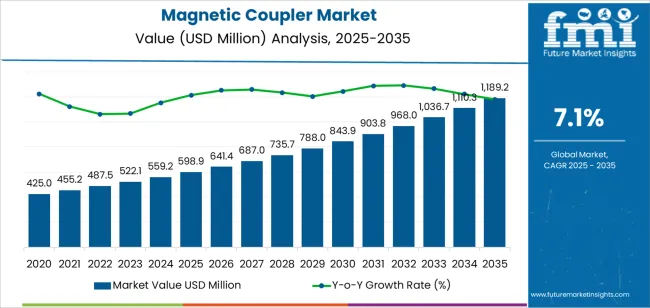
The latter half (2030-2035) will witness sustained growth from USD 787.9 million to USD 1,189.2 million, representing an addition of USD 401.3 million or 68% of the decade's expansion. This period will be defined by mass market penetration of specialized magnetic coupler designs, integration with comprehensive process control platforms, and seamless compatibility with existing industrial infrastructure. The market trajectory signals fundamental shifts in how manufacturers approach transmission system optimization and reliability quality management, with participants positioned to benefit from sustained demand across multiple magnet types and end-use application segments.
The Magnetic Coupler market demonstrates distinct growth phases with varying market characteristics and competitive dynamics. Between 2025 and 2030, the market progresses through its technology adoption phase, expanding from USD 598.9 million to USD 787.9 million with steady annual increments averaging 7.1% growth. This period showcases the transition from basic coupling systems to advanced rare earth magnet couplers with enhanced torque transmission capabilities and integrated monitoring systems becoming mainstream features.
The 2025-2030 phase adds USD 189.0 million to market value, representing 32% of total decade expansion. Market maturation factors include standardization of power transmission protocols and industrial coupling systems, declining component costs for specialized magnetic assemblies, and increasing industry awareness of leak-free transmission benefits reaching optimal torque transfer effectiveness in chemical and pharmaceutical applications. Competitive landscape evolution during this period features established power transmission manufacturers expanding their magnetic coupler portfolios while specialty manufacturers focus on advanced magnet development and enhanced coupling capabilities.
From 2030 to 2035, market dynamics shift toward advanced technology integration and global industrial expansion, with growth continuing from USD 787.9 million to USD 1,189.2 million, adding USD 401.3 million or 68% of total expansion. This phase transition centers on specialized magnetic coupling systems, integration with automated process networks, and deployment across diverse chemical and food processing scenarios, becoming standard rather than specialized applications. The competitive environment matures with focus shifting from basic coupling capability to comprehensive transmission optimization systems and integration with process monitoring platforms.
| Metric | Value |
|---|---|
| Market Value (2025) | USD 598.9 million |
| Market Forecast (2035) | USD 1,189.2 million |
| Growth Rate | 7.1% CAGR |
| Leading Technology | Rare Earth Magnet Couplers Magnet Type |
| Primary Application | Chemicals Application Segment |
The market demonstrates strong fundamentals with rare earth magnet coupler systems capturing a dominant share through advanced coupling design and torque optimization capabilities. Chemical applications drive primary demand, supported by increasing process equipment requirements and leak-free transmission technology needs. Geographic expansion remains concentrated in developed markets with established process industry infrastructure, while emerging economies show accelerating adoption rates driven by chemical manufacturing expansion and rising safety standards.
Market expansion rests on three fundamental shifts driving adoption across the chemical, pharmaceutical, and food processing sectors. First, process safety enhancement demand creates compelling operational advantages through magnetic couplers that provide immediate leak prevention and contamination elimination without compromising transmission efficiency, enabling manufacturers to meet stringent environmental standards while maintaining operational productivity and reducing seal failure risks. Second, process equipment modernization accelerates as industrial facilities worldwide seek advanced coupling systems that complement traditional mechanical seals, enabling precise torque transmission and hermetic isolation that align with industry standards and safety regulations.
Third, cleanroom manufacturing enhancement drives adoption from pharmaceutical producers and food processors requiring effective isolation solutions that maximize product purity while maintaining operational productivity during mixing and pumping operations. However, growth faces headwinds from equipment cost challenges that vary across coupling suppliers regarding the sourcing of rare earth magnets and precision components, which may limit adoption in cost-sensitive environments. Technical limitations also persist regarding torque capacity constraints and temperature sensitivity concerns that may reduce effectiveness in high-power applications and extreme operating scenarios, which affect coupling performance and design requirements.
The magnetic coupler market represents a specialized yet critical power transmission opportunity driven by expanding global chemical production, process equipment modernization, and the need for superior contamination prevention in diverse industrial applications. As manufacturers worldwide seek to achieve leak-free operation effectiveness, reduce environmental risks, and integrate advanced coupling systems with automated platforms, magnetic couplers are evolving from basic transmission components to sophisticated isolation solutions ensuring process safety and operational leadership.
The market's growth trajectory from USD 598.9 million in 2025 to USD 1,189.2 million by 2035 at a 7.1% CAGR reflects fundamental shifts in process industry safety requirements and coupling technology optimization. Geographic expansion opportunities are particularly pronounced in Asia Pacific markets, while the dominance of rare earth magnet systems and chemical applications provides clear strategic focus areas.
Strengthening the dominant rare earth magnet segment through enhanced magnetic formulations, superior torque density, and optimized coupling geometries. This pathway focuses on optimizing magnet composition, improving power transmission capabilities, extending operational effectiveness to advanced torque transfer rates, and developing specialized designs for diverse applications. Market leadership consolidation through advanced magnetic engineering and precision manufacturing integration enables premium positioning while defending competitive advantages against alternative coupling technologies. Expected revenue pool: USD 80-110 million
Rapid chemical industry and pharmaceutical facility growth across Asia Pacific creates substantial expansion opportunities through local coupling production capabilities and technology transfer partnerships. Growing process equipment demand and industrial development initiatives drive sustained demand for advanced magnetic coupling systems. Localization strategies reduce import costs, enable faster technical support, and position companies advantageously for procurement programs while accessing growing domestic markets. Expected revenue pool: USD 70-95 million
Expansion within the dominant chemical segment (approximately 50% market share) through specialized coupling designs addressing process industry standards and high-volume production requirements. This pathway encompasses corrosion-resistant systems, hazardous area integration, and compatibility with diverse chemical processing equipment. Premium positioning reflects superior safety performance and comprehensive environmental compliance supporting modern chemical operations. Expected revenue pool: USD 60-85 million
Strategic expansion into pharmaceutical applications (approximately 30% market share) requires enhanced cleanroom capabilities and specialized coupling systems addressing sterile processing requirements. This pathway addresses contamination prevention design, validation documentation enhancement, and cGMP-compliant coupling with advanced material engineering for demanding pharmaceutical standards. Premium pricing reflects specialized validation requirements and extended compliance standards. Expected revenue pool: USD 50-70 million
Development of specialized magnetic couplers for food and beverage applications (approximately 15% market share), addressing specific sanitary requirements and hygienic processing demands. This pathway encompasses FDA-compliant designs, clean-in-place compatibility, and cost-effective alternatives for emerging food processing segments. Technology differentiation through sanitary design enables diversified revenue streams while reducing dependency on single application platforms. Expected revenue pool: USD 40-55 million
Expansion of ferrite magnet segment through cost-optimized designs, moderate torque applications, and specialized standard-duty requirements. This pathway encompasses general industrial applications, lower-power equipment, and configurations requiring economical magnetic coupling characteristics. Market development through ferrite technology enables competitive positioning while accessing cost-sensitive markets requiring reliable coupling solutions. Expected revenue pool: USD 30-45 million
Development of advanced magnetic couplers addressing extreme temperature requirements and specialized operating conditions across chemical and industrial applications. This pathway encompasses high-temperature magnet materials, thermal management integration, and comprehensive performance documentation. Premium positioning reflects engineering expertise and specialty capabilities while enabling access to demanding process applications and extreme-environment partnerships. Expected revenue pool: USD 25-35 million
Primary Classification: The market segments by magnet type into Rare Earth Magnet Couplers, Ferrite Magnet Couplers, and Other categories, representing the evolution from basic coupling components to specialized magnetic transmission solutions for comprehensive process isolation optimization.
Secondary Classification: Application segmentation divides the market into Chemicals, Pharmaceuticals, Food and Beverages, and Other sectors, reflecting distinct requirements for contamination prevention, torque capacity, and safety compliance standards.
Regional Classification: Geographic distribution covers Asia Pacific, Europe, North America, and other regions, with developed markets leading adoption while emerging economies show accelerating growth patterns driven by chemical industry expansion programs.
The segmentation structure reveals technology progression from standard ferrite-based couplers toward specialized rare earth systems with enhanced torque and reliability capabilities, while application diversity spans from chemical processing to specialized pharmaceutical and food applications requiring precise contamination-free solutions.
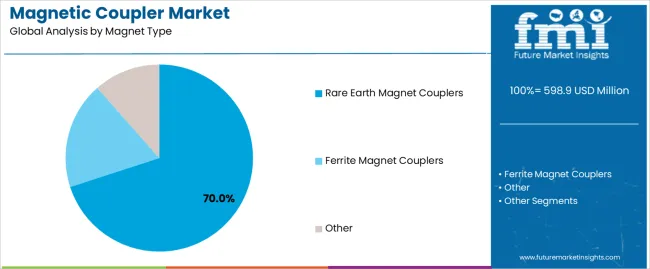
Market Position: Rare earth magnet coupler systems command the leading position in the Magnetic Coupler market with approximately 70% market share through advanced magnetic properties, including superior torque density, compact design capability, and transmission optimization that enable manufacturers to achieve optimal power transfer across diverse chemical and pharmaceutical environments.
Value Drivers: The segment benefits from process engineer preference for high-performance coupling systems that provide consistent torque transmission, reduced equipment footprint, and leak-free operation without requiring significant system modifications. Advanced magnetic features enable precision torque control, power consistency, and integration with existing process equipment, where coupling performance and reliability represent critical operational requirements.
Competitive Advantages: Rare earth magnet couplers differentiate through proven torque density, consistent magnetic characteristics, and integration with process control systems that enhance operational effectiveness while maintaining optimal safety suitable for diverse industrial applications.
Key market characteristics:
Ferrite magnet coupler systems maintain cost-effective material positioning in the Magnetic Coupler market due to their economical magnetic properties and standard application advantages. These systems appeal to manufacturers requiring reliable coupling with adequate performance for moderate-duty industrial and general process applications. Market adoption is driven by industrial expansion, emphasizing reliable transmission solutions and operational economy through optimized ferrite designs while maintaining competitive torque capabilities.

Market Context: Chemical applications dominate the Magnetic Coupler market with approximately 50% market share due to widespread adoption of leak-free process equipment and increasing focus on environmental protection, worker safety, and emission reduction applications that minimize hazardous material exposure while maintaining chemical processing standards.
Appeal Factors: Chemical manufacturers prioritize coupling reliability, corrosion resistance, and integration with existing process infrastructure that enables coordinated transmission application across multiple production lines. The segment benefits from substantial environmental investment and safety programs that emphasize the acquisition of magnetic couplers for leak prevention and worker protection applications.
Growth Drivers: Chemical production expansion programs incorporate magnetic couplers as standard equipment for pumping operations, while environmental compliance initiatives increase demand for zero-emission capabilities that comply with safety standards and minimize fugitive emissions.
Market Challenges: Varying chemical compositions and process conditions may limit coupling standardization across different production facilities or operational scenarios.
Application dynamics include:
Pharmaceutical applications capture approximately 30% market share through specialized contamination prevention requirements in sterile manufacturing facilities, API production operations, and cleanroom processing applications. These facilities demand robust coupling systems capable of hermetic sealing while providing exceptional torque transmission and validation-compliant capabilities.
Food and beverage applications account for approximately 15% market share, while other segments capture 5%, including water treatment facilities, general industrial equipment, and specialized processing applications requiring magnetic coupling capabilities for contamination prevention and operational safety.
Growth Accelerators: Chemical safety expansion drives primary adoption as magnetic couplers provide superior leak prevention capabilities that enable process facilities to meet stringent environmental standards without excessive equipment costs, supporting industrial operations and safety missions that require precise contamination prevention applications. Process equipment infrastructure demand accelerates market expansion as chemical producers seek effective coupling systems that minimize emission risks while maintaining operational effectiveness during pumping and mixing scenarios. Industrial safety spending increases worldwide, creating sustained demand for magnetic coupling systems that complement traditional mechanical seals and provide leak elimination in hazardous processing environments.
Growth Inhibitors: Equipment cost challenges vary across coupling suppliers regarding the sourcing of rare earth magnets and precision manufacturing components, which may limit operational flexibility and market penetration in regions with budget constraints or cost-sensitive industrial operations. Technical performance limitations persist regarding torque capacity constraints and temperature sensitivity that may reduce effectiveness in high-power applications, extreme temperature conditions, or demanding operational scenarios, affecting coupling reliability and design requirements. Market fragmentation across multiple industry standards and equipment specifications creates compatibility concerns between different coupling suppliers and existing process infrastructure.
Market Evolution Patterns: Adoption accelerates in chemical processing and pharmaceutical facilities where contamination prevention justifies coupling costs, with geographic concentration in developed markets transitioning toward mainstream adoption in emerging economies driven by chemical industry expansion and environmental awareness. Technology development focuses on enhanced magnet materials, improved thermal management, and compatibility with process automation systems that optimize torque transmission and equipment effectiveness. The market could face disruption if alternative sealing technologies or advanced mechanical seal innovations significantly limit the deployment of magnetic couplers in process applications, though magnetic coupling technology's unique combination of zero-leakage operation, maintenance-free performance, and hermetic isolation continues to make it preferred in chemical applications.
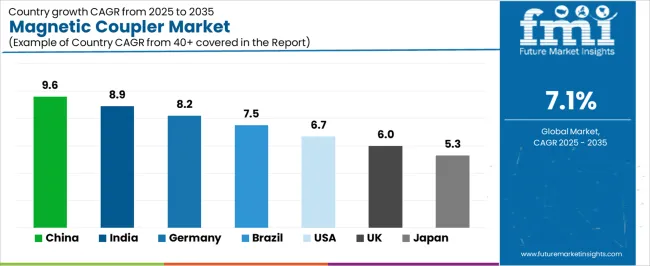
The magnetic coupler market demonstrates varied regional dynamics with Growth Leaders including China (9.6% CAGR) and India (8.9% CAGR) driving expansion through chemical industry capacity additions and pharmaceutical manufacturing programs. Steady Performers encompass Germany (8.2% CAGR), Brazil (7.5% CAGR), United States (6.7% CAGR), and United Kingdom (6.0% CAGR), benefiting from established chemical industries and advanced process equipment adoption. Mature Markets feature Japan (5.3% CAGR), where specialized pharmaceutical applications and precision coupling integration support consistent growth patterns.
| Country | CAGR (2025-2035) |
|---|---|
| China | 9.6% |
| India | 8.9% |
| Germany | 8.2% |
| Brazil | 7.5% |
| United States | 6.7% |
| United Kingdom | 6.0% |
| Japan | 5.3% |
Regional synthesis reveals Asia Pacific markets leading adoption through chemical industry expansion and pharmaceutical infrastructure development, while European countries maintain steady expansion supported by process technology advancement and environmental standardization requirements. North American markets show moderate growth driven by chemical facility applications and safety equipment integration trends.

The Chinese market emphasizes advanced coupling features, including precision torque control and integration with comprehensive process platforms that manage transmission quality, leak prevention optimization, and safety applications through unified monitoring systems. The country demonstrates strong growth at 9.6% CAGR, driven by chemical industry expansion, pharmaceutical manufacturing initiatives, and emerging process equipment development that support magnetic coupler integration. Chinese manufacturers prioritize operational effectiveness with magnetic couplers delivering consistent leak-free performance through advanced magnetic capabilities and system adaptation features.
Technology deployment channels include major chemical producers, specialized coupling suppliers, and industrial equipment procurement programs that support professional applications for complex process isolation and contamination prevention applications. Process platform integration capabilities with established chemical systems expand market appeal across diverse operational requirements seeking leak-free transmission and safety benefits. The expanding chemical sector and accelerating pharmaceutical market create sustained demand, while innovative applications in food processing and cleanroom manufacturing open new growth avenues.
Performance Metrics:
Advanced industrial market in Germany demonstrates sophisticated magnetic coupler deployment with documented operational effectiveness in chemical processing applications and pharmaceutical facilities through integration with existing process systems and equipment infrastructure. The country leverages engineering expertise in power transmission and process systems integration to maintain strong growth at 8.2% CAGR. Industrial centers, including Frankfurt, Munich, and Hamburg, showcase premium installations where magnetic coupling systems integrate with comprehensive process platforms and safety management systems to optimize leak prevention and transmission effectiveness.
German coupling manufacturers prioritize system reliability and EU compliance in product development, creating demand for premium rare earth systems with advanced features, including hazardous area certification and automated monitoring integration. The market benefits from established chemical industry infrastructure and a willingness to invest in safety technologies that provide long-term environmental benefits and compliance with international process and quality standards.
Market Intelligence Brief:
USA magnetic coupler market demonstrates sophisticated deployment across chemical applications with documented effectiveness in process equipment and pharmaceutical facilities through integration with comprehensive safety management systems and environmental compliance infrastructure. The country leverages advanced manufacturing capabilities in coupling innovation and process technologies to maintain moderate growth at 6.7% CAGR. Industrial centers, including major chemical facilities and pharmaceutical operations, showcase premium installations where magnetic coupling systems integrate with comprehensive process platforms and safety networks to optimize leak prevention and transmission effectiveness.
American process facilities prioritize equipment reliability and environmental compliance in coupling development, creating demand for innovative magnetic systems with advanced features, including smart monitoring integration and automated diagnostics systems. The market benefits from established chemical infrastructure and willingness to invest in safety technologies that provide long-term environmental benefits and compliance with EPA and process safety standards.
Market Intelligence Brief:
The UK magnetic coupler market demonstrates advanced safety deployment with documented operational effectiveness in chemical processing applications and pharmaceutical facilities through integration with existing environmental compliance systems and process infrastructure. The country leverages regulatory expertise in process safety and equipment systems integration to maintain steady growth at 6.0% CAGR. Industrial centers, including London, Manchester, and Birmingham, showcase premium installations where magnetic coupling systems integrate with comprehensive safety platforms and process management systems to optimize environmental compliance and transmission effectiveness.
British process facilities prioritize system safety and regulatory compliance in coupling development, creating demand for certified magnetic systems with advanced features, including emission tracking and safety integration. The market benefits from established chemical infrastructure and commitment to invest in environmental technologies that provide long-term safety benefits and compliance with UK process standards. Chemical applications, pharmaceutical safety systems, and compliance-focused processing programs drive diversified demand across multiple end-use segments.
Strategic Market Indicators:
India's magnetic coupler market demonstrates rapid expansion deployment with documented operational effectiveness in chemical processing applications and pharmaceutical facilities through integration with emerging industrial systems and process infrastructure. The country leverages growing manufacturing capabilities in coupling technology and process systems integration to achieve high growth at 8.9% CAGR. Industrial centers, including Mumbai, Delhi, and Bangalore, showcase expanding installations where magnetic coupling systems integrate with comprehensive process platforms and safety networks to optimize market penetration and transmission effectiveness.
Indian process facilities prioritize quality positioning and international standards in coupling development, creating demand for sophisticated magnetic systems with advanced features, including leak prevention integration and safety monitoring systems. The market benefits from expanding chemical infrastructure and willingness to invest in international-standard safety technologies that provide environmental compliance and compliance with global process standards.
Market Intelligence Brief:
Brazil's magnetic coupler market demonstrates expanding deployment with documented operational effectiveness in chemical processing applications and industrial facilities through integration with process systems and equipment infrastructure. The country leverages developing industrial capabilities in coupling equipment and process systems integration to achieve strong growth at 7.5% CAGR. Industrial centers showcase growing installations where magnetic coupling systems integrate with process platforms and safety networks to optimize transmission effectiveness.
Brazilian process facilities prioritize equipment reliability and environmental standards in coupling development, creating demand for cost-effective magnetic systems with adequate features, including leak prevention integration and safety monitoring systems. The market benefits from expanding chemical infrastructure and industrial development programs supporting coupling technology adoption.
Japan's magnetic coupler market demonstrates precision deployment with documented operational effectiveness in pharmaceutical processing applications and chemical facilities through integration with advanced process systems and quality infrastructure. The country leverages engineering excellence in precision manufacturing and process systems integration to maintain steady growth at 5.3% CAGR. Industrial centers, including Tokyo, Osaka, and Yokohama, showcase premium installations where magnetic coupling systems integrate with comprehensive quality platforms and process systems to optimize transmission excellence and coupling effectiveness.
Japanese process facilities prioritize system precision and manufacturing excellence in coupling development, creating demand for ultra-premium magnetic systems with advanced features, including micro-precision torque control and quality integration systems. The market benefits from established pharmaceutical infrastructure and commitment to invest in highest-quality safety technologies that provide superior process positioning and compliance with stringent Japanese quality standards.
Strategic Market Indicators:
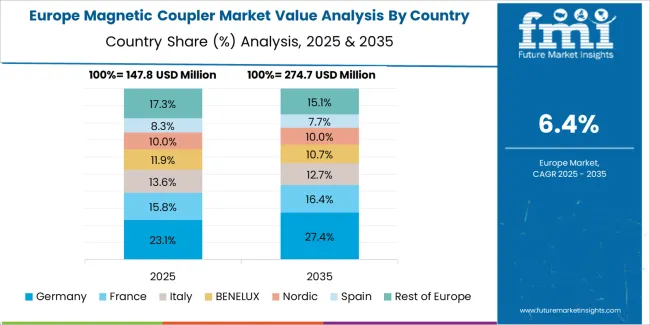
The Magnetic Coupler market in Europe is projected to grow substantially over the forecast period, with Germany expected to maintain its leadership position with a significant market share supported by its advanced chemical industry infrastructure and major process centers in Frankfurt and Munich. United Kingdom follows with strong market presence, driven by comprehensive environmental programs and process safety initiatives. France holds substantial market share through specialized chemical processing activities, coupling equipment applications, and pharmaceutical facility operations. Italy commands notable market presence through chemical industry and pharmaceutical manufacturing projects. Spain accounts for growing market share aided by industrial expansion and process equipment adoption. The Netherlands maintains steady share driven by specialty chemical applications and coupling demand. The Rest of Europe region is anticipated to show steady adoption, reflecting consistent growth in Nordic countries, chemical industry expansion in Central European markets, and coupling equipment upgrades across Eastern European process facilities.
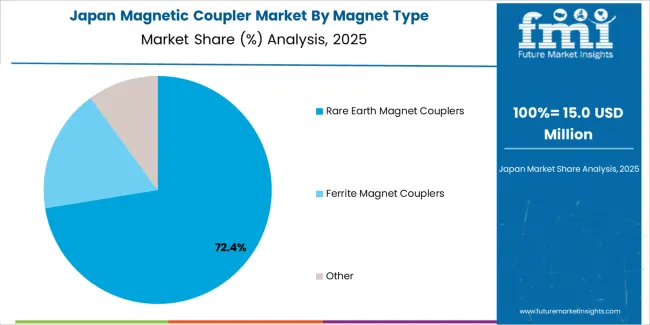
In Japan, the Magnetic Coupler market prioritizes rare earth magnet systems, which capture the dominant share of pharmaceutical and chemical processing installations due to their advanced features, including precision torque density optimization and seamless integration with existing process equipment infrastructure. Japanese process facilities emphasize reliability, precision, and long-term transmission excellence, creating demand for rare earth magnet systems that provide consistent coupling capabilities and superior magnetic performance based on processing requirements and quality standards. Ferrite magnet couplers maintain secondary positions primarily in general industrial applications and standard-duty installations where comprehensive transmission functionality meets operational requirements without compromising cost efficiency.
Market Characteristics:

In South Korea, the market structure favors international coupling manufacturers, including KTR Systems GmbH, Magnetic Technologies Ltd., and EagleBurgmann (Sealmatic), which maintain dominant positions through comprehensive product portfolios and established chemical industry networks supporting both process equipment and pharmaceutical facility installations. These providers offer integrated solutions combining advanced magnetic coupling systems with professional engineering services and ongoing technical support that appeal to Korean process facilities seeking reliable leak-free transmission systems. Local equipment distributors and mechanical service providers capture moderate market share by providing localized installation capabilities and competitive pricing for standard process coupling installations, while domestic manufacturers focus on specialized applications and cost-effective solutions tailored to Korean chemical industry market characteristics.
Channel Insights:
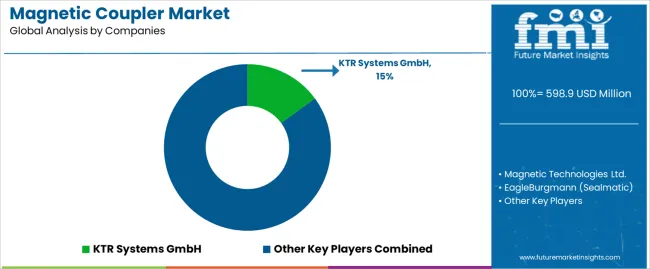
The Magnetic Coupler market operates with moderate concentration, featuring approximately 15-18 meaningful participants, where leading companies control roughly 45-50% of the global market share through established chemical industry relationships and comprehensive magnetic coupling portfolios. Competition emphasizes advanced magnetic capabilities, system reliability, and process integration rather than price-based rivalry. The leading companies maintain competitive positions through extensive coupling product lines and global chemical industry presence.
Market Leaders encompass KTR Systems GmbH, Magnetic Technologies Ltd., and EagleBurgmann (Sealmatic), which maintain competitive advantages through extensive power transmission expertise, global chemical industry networks, and comprehensive process integration capabilities that create customer loyalty and support premium pricing. These companies leverage decades of magnetic coupling experience and ongoing innovation investments to develop advanced coupling systems with precision torque control and leak-free features. Technology Innovators include Siemens AG, Dexter Magnetic Technologies, and regional specialists, which compete through specialized magnetic technology focus and innovative coupling capabilities that appeal to process facilities seeking advanced contamination prevention solutions and safety differentiation.
These companies differentiate through rapid product development cycles and specialized chemical application focus. Regional Specialists feature coupling manufacturers focusing on specific geographic markets and specialized applications, including high-temperature systems and integrated process solutions. Market dynamics favor participants that combine reliable magnetic designs with advanced engineering capabilities, including precision torque control and automatic leak detection optimization features. Competitive pressure intensifies as traditional power transmission suppliers expand into specialized magnetic coupling systems, while dedicated process equipment companies challenge established players through innovative magnetic solutions and safety platforms targeting chemical processing and pharmaceutical manufacturing segments.
| Item | Value |
|---|---|
| Quantitative Units | USD 598.9 million |
| Magnet Type | Rare Earth Magnet Couplers, Ferrite Magnet Couplers, Other |
| Application | Chemicals, Pharmaceuticals, Food and Beverages, Other |
| Regions Covered | Asia Pacific, Europe, North America, Latin America, Middle East & Africa |
| Countries Covered | China, India, Germany, Brazil, United States, United Kingdom, Japan, and additional countries |
| Key Companies Profiled | KTR Systems GmbH, Magnetic Technologies Ltd., EagleBurgmann (Sealmatic), Siemens AG, Dexter Magnetic Technologies, MagneTek (Regal Rexnord), Sumitomo Drive Technologies, Rexnord Corporation, HMS Industrial Networks, Saftty Electronic Technology Co., Ltd., ZF Friedrichshafen AG, ABB Group, VISCOTEC, Adams Magnetic Products, Johnson Electric |
| Additional Attributes | Dollar sales by magnet type and application categories, regional adoption trends across Asia Pacific, Europe, and North America, competitive landscape with coupling manufacturers and process equipment suppliers, facility preferences for leak-free operation and torque transmission, integration with process control platforms and safety monitoring systems, innovations in rare earth magnet formulations and coupling excellence, and development of contamination-free transmission solutions with enhanced performance and process optimization capabilities. |
The global magnetic coupler market is estimated to be valued at USD 598.9 million in 2025.
The market size for the magnetic coupler market is projected to reach USD 1,189.2 million by 2035.
The magnetic coupler market is expected to grow at a 7.1% CAGR between 2025 and 2035.
The key product types in magnetic coupler market are rare earth magnet couplers , ferrite magnet couplers and other.
In terms of application, chemicals segment to command 50.0% share in the magnetic coupler market in 2025.






Full Research Suite comprises of:
Market outlook & trends analysis
Interviews & case studies
Strategic recommendations
Vendor profiles & capabilities analysis
5-year forecasts
8 regions and 60+ country-level data splits
Market segment data splits
12 months of continuous data updates
DELIVERED AS:
PDF EXCEL ONLINE
Magnetic Material Magnetization and Testing Equipment Market Size and Share Forecast Outlook 2025 to 2035
Magnetic Shielding Device Market Size and Share Forecast Outlook 2025 to 2035
Magnetic Stripe Readers Market Size and Share Forecast Outlook 2025 to 2035
Magnetic Resonance Analyzer Market Size and Share Forecast Outlook 2025 to 2035
Magnetic Drive Pump Market Size and Share Forecast Outlook 2025 to 2035
Magnetic Separator Market Size and Share Forecast Outlook 2025 to 2035
Magnetic Ballast Market Size and Share Forecast Outlook 2025 to 2035
Magnetic Sensor Market Size and Share Forecast Outlook 2025 to 2035
Magnetic Flowmeter Market Size and Share Forecast Outlook 2025 to 2035
Magnetic Resonance Imaging Coils Market Analysis - Size, Share, and Forecast 2025 to 2035
Magnetic Tape Market Analysis Size and Share Forecast Outlook 2025 to 2035
Magnetic Resonance Imaging (MRI) Contrast Agents Market Size and Share Forecast Outlook 2025 to 2035
Magnetic Crack Detectors Market Size and Share Forecast Outlook 2025 to 2035
Magnetic Materials Market Growth - Trends & Forecast 2025 to 2035
Magnetic Resonance Imaging (MRI) Market Trends - Size, Share & Forecast 2025 to 2035
Magnetic Grill Market Analysis – Trends, Growth & Forecast 2025 to 2035
Magnetic Closure Boxes Market Trends - Growth & Demand 2025 to 2035
Magnetic Charging Cable Market Trends - Growth & Forecast 2025 to 2035
Magnetic Flow Meter Market Analysis by Product Type, Components, Technology, Application and Region - Trends, Growth & Forecast 2025 to 2035
Competitive Breakdown of Magnetic Resonance Imaging Coils Suppliers

Thank you!
You will receive an email from our Business Development Manager. Please be sure to check your SPAM/JUNK folder too.
Chat With
MaRIA